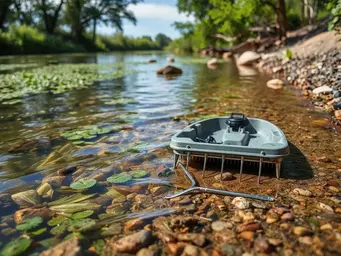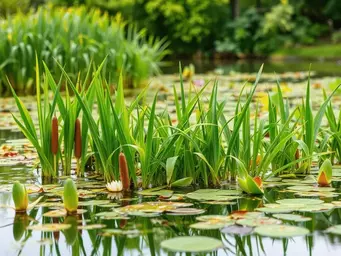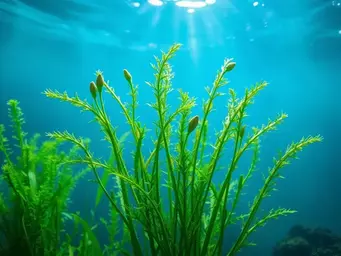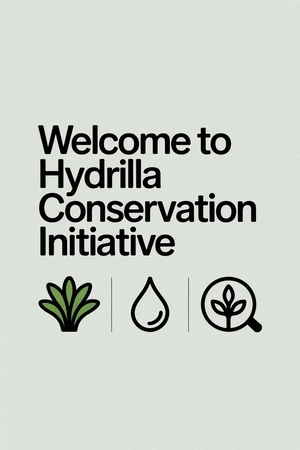As we explore the complexities of hydrilla, consider this: the rapid growth of this invasive aquatic plant can dramatically alter ecosystems. What if understanding its biology could empower you to contribute to its management? Dive into the key insights below!
What You Will Learn
- Germination Conditions: Hydrilla seeds or tubers sprout in warm temperatures, typically above 15°C, initiating its life cycle.
- Rapid Growth Rates: Under optimal conditions, hydrilla can grow up to 1 inch per day, making it a formidable invader.
- Reproductive Strategies: Hydrilla utilizes both asexual reproduction through fragmentation and sexual reproduction via turions, enhancing its invasiveness.
- Environmental Adaptability: This plant can thrive in still or flowing waters, adjusting its growth patterns to the environment.
- Water Quality Impact: Eutrophication and low oxygen levels favor hydrilla growth, necessitating careful water management.
- Ecosystem Dynamics: Dense mats formed by hydrilla can provide habitat but also suffocate native plants, disrupting local biodiversity.
Understanding Hydrilla's Life Cycle and Growth Factors
This visual summarizes the key stages of Hydrilla's life cycle and the environmental factors influencing its growth and distribution.
Key Life Cycle Stages
- ✓ Germination: Seeds/tubers sprout (above 15°C).
- ✓ Vegetative Growth: Rapid growth (up to 1 inch/day).
- ✓ Flowering: Primarily spreads via fragmentation.
- ✓ Propagation: Tubers ensure persistence.
Factors Influencing Growth
- ● Temperature: Warmer waters accelerate growth.
- ● Light Availability: Thrives in well-lit environments.
- ● Nutrient Levels: High concentrations lead to explosive growth.
Water Quality Impacts
- ■ Oxygen Levels: Low oxygen benefits hydrilla.
- ■ pH Levels: Prefers slightly acidic to neutral pH.
- ■ Salinity: Freshwater systems vulnerable.
Growth Adaptations
- ✓ Still Waters: Forms dense mats.
- ✓ Flowing Streams: Anchors to substrates.
- ✓ Variable Depths: Grows 1 to 15 feet deep.
Unraveling Hydrilla Biology: An Insight into Its Life Cycle
Understanding hydrilla biology is crucial for anyone working to manage this invasive species. Through my years of research, I've seen how vital it is to grasp the intricacies of hydrilla’s life cycle. Let’s dive into the details that make this plant an effective conqueror of our waterways!
Understanding the Life Cycle of Hydrilla verticillata
Key Stages in the Life Cycle: From Germination to Maturity
The life cycle of Hydrilla verticillata involves several key stages, each contributing to its rapid spread. It begins with germination, where seeds or tubers sprout in favorable conditions. These sprouts quickly develop into robust plants, thriving in diverse environments.
- Germination: Seeds or turions begin to sprout in warm temperatures (typically above 15°C).
- Vegetative Growth: Plants grow quickly, sometimes up to 1 inch per day!
- Flowering: While hydrilla can flower, it primarily spreads through fragmentation.
- Propagation: The plant produces tubers that can survive adverse conditions, ensuring its persistence.
Understanding these stages helps us recognize when and how hydrilla can invade new areas. Each phase is an opportunity to control its spread before it establishes a stronghold.
Factors Influencing Growth Rates in Hydrilla
Several factors influence the growth rates of hydrilla, making it a formidable opponent. Key aspects include:
- Temperature: Warmer waters accelerate growth.
- Light Availability: Hydrilla thrives in well-lit environments.
- Nutrient Levels: High nutrient concentrations can lead to explosive growth.
Recognizing these factors allows us to predict when hydrilla might become problematic. For instance, in nutrient-rich waters, the chances of rapid expansion increase significantly! For further insights into its biological characteristics and environmental impacts, you can refer to this detailed study on hydrilla's impact on aquatic ecosystems.
The Role of Water Quality in Hydrilla Growth and Distribution
Water quality is a critical factor in the success of hydrilla. Poorly managed waters can lead to eutrophication, which provides the nutrients hydrilla needs to flourish. Monitoring water quality helps us understand where hydrilla is most likely to thrive.
- Oxygen Levels: Low oxygen often benefits hydrilla, as it can outcompete native species.
- pH Levels: Hydrilla prefers slightly acidic to neutral pH, which can shift the entire ecosystem.
- Salinity: Freshwater systems are particularly vulnerable to hydrilla invasion.
By maintaining good water quality, we can combat hydrilla's spread and protect native aquatic life. Our mission at the Hydrilla Conservation Initiative is to provide resources that help manage these conditions effectively, as highlighted in this public messaging document on Hydrilla management.
Growth Patterns of Hydrilla: Adaptations and Implications
How Hydrilla Thrives in Various Aquatic Environments
One of the remarkable aspects of hydrilla is its adaptability. This aquatic plant can thrive in both still and flowing waters, making it a versatile invader. It can adjust its growth patterns based on the environment, which is why it can be found in lakes, rivers, and canals.
- Still Waters: Hydrilla can form dense mats, creating a habitat for itself.
- Flowing Streams: It can anchor to substrates, preventing washout.
- Variable Depths: Hydrilla can grow from depths of 1 to 15 feet depending on the light penetration.
This adaptability is a critical reason why hydrilla can dominate aquatic ecosystems, altering habitats and impacting native species.
The Role of Dense Mats in Ecosystem Dynamics
The dense mats formed by hydrilla have significant implications for the ecosystem. While they provide habitat for certain fish species, they can also suffocate native plants and disrupt natural habitats.
- Habitat Formation: Dense growth can shelter small fish.
- Light Blocking: These mats block light from reaching submerged plants, harming biodiversity.
- Water Quality Changes: Decomposing mats can lower oxygen levels in the water.
Understanding these dynamics is essential for effective management strategies. By recognizing hydrilla's role in the ecosystem, we can develop targeted approaches to mitigate its negative impacts. More information on its distribution and ecological effects can be found in this report on invasive species.
Impact of Environmental Conditions on Hydrilla Growth
Environmental conditions significantly influence hydrilla growth. Factors such as temperature, light, and nutrient levels create a perfect storm for hydrilla's success. For example, warmer temperatures promote faster growth, while increased nutrients can lead to more robust populations.
- Seasonal Changes: Growth can fluctuate with seasonal temperature changes.
- Rainfall Patterns: Increased rainfall can wash nutrients into water bodies, fueling hydrilla.
- Human Activity: Urban runoff often leads to nutrient pollution, exacerbating hydrilla issues.
As environmental stewards, it’s our responsibility to monitor these conditions and act accordingly to manage hydrilla populations in our waterways. Together, we can create strategies to protect our aquatic ecosystems!
Pro Tip
To effectively manage hydrilla, consider implementing integrated management techniques that combine mechanical removal, biological controls, and community engagement. This holistic approach not only addresses the immediate issues caused by hydrilla but also fosters long-term ecological balance in affected waterways.
Summary of Hydrilla Biology and Its Ecological Significance
As we've explored the intricacies of hydrilla's biology, several key takeaways stand out regarding its life cycle and reproductive strategies. Understanding these elements is essential for anyone involved in environmental conservation or management, especially considering the rapid proliferation of this invasive aquatic plant.
Hydrilla’s ability to reproduce both asexually through fragmentation and sexually via turions and seed production allows it to adapt quickly to varying environmental conditions. This dual strategy not only enhances its survivability but also complicates control measures. As an aquatic biologist, I have witnessed firsthand how these reproductive mechanisms can lead to the domination of local ecosystems.
Key Takeaways on Life Cycle and Reproductive Strategies
- Asexual reproduction through fragmentation allows hydrilla to spread rapidly across water bodies.
- Turions serve as a crucial survival mechanism, enabling the plant to withstand unfavorable conditions.
- The combination of vegetative and sexual reproduction contributes to hydrilla's resilience and invasiveness in various ecosystems.
These insights into hydrilla's life cycle highlight why it’s critical to engage in effective management practices. By understanding the reproductive strategies of hydrilla, we can devise more targeted approaches to mitigate its impact on native aquatic species.
Importance of Managing Hydrilla to Protect Ecosystems
The management of hydrilla is not merely a matter of controlling a pesky weed; it’s about preserving the ecological balance of our freshwater habitats. As stewards of the environment, we have a responsibility to protect native species and the ecosystems they inhabit. The Hydrilla Conservation Initiative is dedicated to providing resources and strategies to address the challenges posed by hydrilla.
Effective management can help restore the health of affected ecosystems, but it requires collective action. I encourage you to consider the following strategies:
- Participate in local community clean-up days focused on invasive species removal.
- Engage with policymakers to advocate for environmental protection laws.
- Educate others about the ecological impacts of hydrilla and other invasive species.
Each of us can play a role in combating the spread of hydrilla. By joining forces, we can create a healthier aquatic environment for future generations!
Call to Action: Join the Efforts in Hydrilla Management and Conservation
Are you passionate about protecting our waterways? Join the efforts of the Hydrilla Conservation Initiative by sharing our resources, participating in educational workshops, and advocating for sustainable practices. Together, we can make a difference and contribute to the conservation of our vital freshwater habitats.
Exploring Conservation Strategies for Freshwater Habitats Affected by Hydrilla
As we explore conservation strategies, it’s vital to consider both immediate and long-term solutions. Implementing integrated management approaches, which combine various control methods, can be particularly effective. Here are some strategies worth exploring:
- Utilizing biological controls, such as introducing natural predators of hydrilla.
- Implementing mechanical removal techniques in heavily infested areas.
- Promoting community awareness and participation in conservation efforts.
By adopting these strategies, we not only combat hydrilla but also work towards restoring the natural balance of our ecosystems. Remember, every action counts! Let's protect our aquatic environments together.
Frequently Asked Questions About Hydrilla
What are the primary reproductive strategies of Hydrilla?
Hydrilla reproduces both asexually through fragmentation (pieces breaking off and growing into new plants) and sexually via the production of turions (overwintering buds) and seeds. This dual strategy contributes significantly to its invasiveness.
How fast can Hydrilla grow under optimal conditions?
Under optimal conditions, particularly in warm, nutrient-rich waters with ample light, Hydrilla can grow very rapidly, sometimes up to 1 inch per day.
What environmental factors contribute to Hydrilla's rapid growth?
Key environmental factors include warm water temperatures (above 15°C), high light availability, and elevated nutrient levels (often due to eutrophication). Low oxygen levels can also benefit hydrilla by inhibiting native species.
How do dense Hydrilla mats impact aquatic ecosystems?
Dense Hydrilla mats can impact ecosystems by providing habitat for some fish species, but they primarily block sunlight, suffocating native submerged plants, and reducing biodiversity. Decomposing mats can also lower water oxygen levels, negatively affecting aquatic life.
What are some effective strategies for managing Hydrilla?
Effective management strategies typically involve integrated approaches, including mechanical removal, the introduction of biological controls (e.g., natural predators), careful water quality management to reduce nutrient levels, and community engagement in conservation efforts.
Recap of Key Points
Here is a quick recap of the important points discussed in the article:
- Life Cycle Stages: Hydrilla's life cycle includes germination, rapid vegetative growth, flowering, and propagation through tubers.
- Growth Influencers: Warm temperatures, adequate light, and high nutrient levels significantly enhance hydrilla's growth rates.
- Water Quality Impact: Poor water quality, including low oxygen and nutrient-rich conditions, supports hydrilla's proliferation.
- Adaptability: Hydrilla thrives in various aquatic environments, adjusting its growth patterns to different conditions.
- Management Strategies: Effective management requires community involvement, policy advocacy, and integrated control methods.






